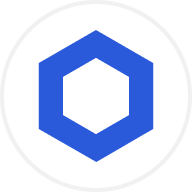Цена Chainlink
в SGD

О Chainlink

Дисклеймер
OKX не дает рекомендаций по инвестированию и хранению активов. Тщательно оцените свою финансовую ситуацию и определите, подходит ли вам торговля и владение цифровыми активами. По вопросам, связанным с вашими конкретными обстоятельствами, обращайтесь к специалистам в области законодательства, налогов или инвестиций. С подробностями можно ознакомиться, изучив Условия использования и Предупреждение о рисках. Переходя на сайты третьих сторон («Сторонние сайты»), вы принимаете их условия использования. OKX и ее партнеры («OKX») не связаны с владельцами и руководителями Сторонних сайтов, если иное не указано в письменной форме. Вы соглашаетесь с тем, что OKX не несет ответственности за убытки, ущерб и любые другие последствия использования Сторонних сайтов. Помните, что использование Сторонних сайтов может привести к полной или частичной потере активов. Продукт может быть доступен не во всех юрисдикциях.
Динамика цен Chainlink
Chainlink в соцсетях
Руководства

Создание бесплатного аккаунта OKX.
Пополнение аккаунта.
Выбор криптовалюты.
Материалы о Chainlink в Академии OKX
Вопросы и ответы о Chainlink
Откройте для себя Chainlink
Chainlink — это децентрализованная сеть оракулов, позволяющая смарт-контрактам на основе блокчейна получать доступ к надежным данным реального мира, хранящимся офчейн. Для этого Chainlink вознаграждает поставщиков данных, называемых оракулами, за предоставление точных и ценных данных в обмен на LINK — нативый токен Chainlink стандарта ERC-20.
Chainlink объединяет около 1000 независимых децентрализованных сетей оракулов, которые предоставляют данные о криптовалютном рынке, курсах валют, индексах, погоде, спортивной статистике, результатах выборов, информации о рейсах и другой информации смарт-контрактам на более чем 12 блокчейн-сетях. Среди блокчейнов, поддерживаемых Chainlink, — Arbitrum, Avalanche, Ethereum, Fantom, Harmony и Polygon.
Чтобы стать оракулом в экосистеме Chainlink, поставщик данных должен сначала внести определенное количество токенов LINK в стейкинг для поддержания целостности сети. Если выяснится, что поставщик данных причастен к подрыву жизнеспособности сети, Chainlink снизит его стейкинг.
Помимо предоставления децентрализованных данных, Chainlink предлагает ряд таких услуг, как Verifiable Random Function (VRF), Keepers, Proof of Reserve (PoR) и Cross-Chain Interoperability Protocol (CCIP). Благодаря Off-Chain Reporting (OCR, офчейн отчетности) ноды могут предоставлять смарт-контрактам в 10 раз больше данных при снижении операционных расходов на 90%.
Цены и токеномика LINK
Объем предложения Chainlink жестко ограничен 1 млрд токенов LINK. Инвесторы получили 35% от общего объема предложения, а для операторов нод и наград за экосистему оставили 35%. Родительская компания Chainlink, SmartContract.com, получила 30% оборота LINK. Токены LINK поступают в обращение, когда операторы нод получают LINK в качестве награды, а инвесторы, владеющие LINK, или проекты, получающие LINK в качестве приобретения, продают их на открытом рынке.
Об основателях
Chainlink был основан в 2017 году серийным предпринимателем Сергеем Назаровом и инженером-программистом Стивом Эллисом. До запуска Chainlink Назаров работал над несколькими проектами, основанными на технологии одноранговой торговли. В 2009 году он стал соучредителем ExistLocal, однорангового маркетплейса для туристов. Пять лет спустя он сыграл важную роль в запуске полностью децентрализованной почтовой службы CryptaMail. Назаров также сотрудничал со Стивом Эллисом, чтобы в 2014 году запустить две другие компании, включая SmartContract.com.
В число технических консультантов Chainlink входят известные деятели индустрии блокчейна и за ее пределами. Среди них — Эрик Шмидт, бывший председатель и генеральный директор Google, Джефф Вейнер, генеральный директор LinkedIn, и Том Гонсер, соучредитель DocuSign. По данным Crunchbase Chainlink привлекла 32 миллиона долларов от таких инвесторов, как Fundamental Labs, Andreas Schwartz и Nirvana Capital.
Основные события Chainlink
Chainlink интегрирует данные о прогнозе погоды из Google Cloud
С 2019 года Google Cloud и Chainlink сотрудничают, чтобы позволить Chainlink использовать данные Google Cloud. В 2021 году Chainlink полностью интегрировала децентрализованные погодные данные из Google Cloud. Для интеграции с Google Chainlink использует нод-оракул, который постоянно отправляет данные из внешней среды в сеть Chainlink. Затем эти данные объединяются и становятся доступными в агрегированном виде для приложений блокчейна.
Партнеры Chainlink — ЮНЕСКО и ЮНИСЕФ
В январе 2021 года компания Chainlink объединила усилия с ЮНЕСКО, чтобы повысить осведомленность о технологии блокчейн и поддержать перспективных участников. Через несколько месяцев Chainlink объявила о партнерстве с ЮНИСЕФ для финансирования приложений блокчейн в развивающихся странах.
Chainlink 2.0
Команда Chainlink раскрыла планы по оптимизации протокола в апреле 2021 года, опубликовав проектный документ Chainlink 2.0. Согласно этому документу, следующий набор обновлений будет направлен на создание надежной и более децентрализованной системы для работы протокола Chainlink. Примечательно, что одним из компонентов этой стратегии является создание механизма поощрения, основанного на стейкинге. В результате Chainlink сможет гарантировать, что вредоносные операторы нод будут наказываться, а честные поставщики данных — вознаграждаться, за счет внедрения экономики стейкинга, основанной на LINK.
В июне 2022 года, более чем через год после публикации, Chainlink объявила, что Chainlink 2.0 позволит держателям LINK делегировать свои средства в стейкинге, чтобы привлечь больше людей к процессу валидации протокола. Кроме того, обновление будет включать расширенную систему отслеживания репутации, которая генерирует показатели эффективности для каждого оператора ноды.






